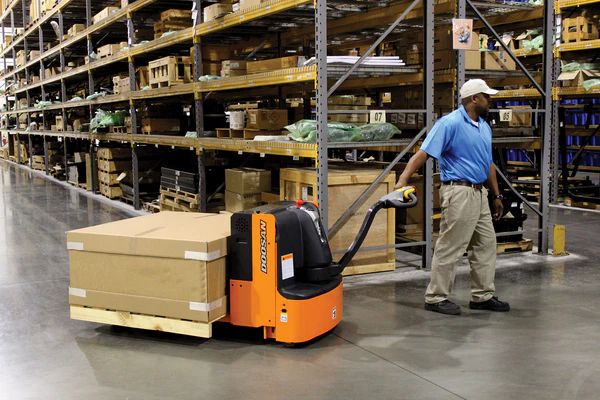In the day-to-day operations of warehouses and logistics facilities, pallet jacks are an indispensable tool for many businesses.
On the other hand, if it is not handled properly, this apparatus can result in injuries, decreased productivity, and costly repairs.
With the help of this guide for pallet jack safety, you will be able to determine how to safely operate a pallet jack.
This will contribute to the continued compliance and productivity of your company.
Inspect Equipment Before Every Shift
Prior to loading or moving any cargo, it is essential to conduct a speedy inspection of the surrounding area.
Look for any signs of wear and tear, such as cracks, leaks, or anything else.
These signs could potentially affect the performance of the bike when you are inspecting the handle, wheels, and forks of the bicycle.
In order to ensure that the up and down mechanisms are able to function without any difficulty, it is essential to test them.
In the event that any issues are found, the pallet jack should be removed from service immediately, and the site supervisor or maintenance team should be notified directly from the beginning.
One straightforward measure that can be taken to reduce the likelihood of major safety incidents is to carry out checks that are the first of their kind.
Match the Pallet Jack to the Job
With regard to new kinds of materials, a variety of different approaches to handling them could be utilised.
Select the appropriate pallet jacks based on load size, capacity, and environment.
Electric pallet trucks are utilised in more heavy-duty applications, whereas manually operated pallet jacks are suitable for use in areas with a smaller footprint or with lighter loads.
Choosing the appropriate model not only reduces the amount of stress experienced by your employees but also increases the lifespan of your equipment.
Using a jack that is either underrated or overweight is detrimental to both safety and performance, so it is imperative that you always adhere to the manufacturer’s weight guidelines.
Position and Load Correctly
There is a direct correlation between the manner in which a pallet jack is loaded and the level of safety that is achieved during the operation.
Besides making sure that the load is evenly distributed, you should also check that the pallet is positioned in the middle of the forks.
When working in conditions that are not balanced, you should avoid leaning or overhanging loads.
Make sure that you always use pallets that are of high quality and have not been damaged, and before lifting, make sure that any loose items are secured.
Two of the many leading causes of tip-overs and accidents that occur in warehouses are stacking items at unreasonable heights and stacking them in an uneven manner.
Lift and Lower With Care
While you are lifting the pallet, lift it a couple of centimetres off the ground.
This will ensure that you are able to keep your equilibrium through the lifting process.
Having said that, the height ought to be sufficiently high to permit movement that is not choppy.
With an excessive amount of height, there is a high probability that instability or a collision will occur.
Check to see that there is no one in close proximity to the forks, and then lower the forks in a steady manner.
Workers and products are both safeguarded by controlled displacement, which is especially advantageous in situations where there is a restricted amount of space within the facility.
Use Correct Handling and Body Mechanics
When it comes to ergonomic design, warehouse safety is an important consideration.
Whenever they are working with heavy loads, the workers should push rather than pull; they should push with their legs rather than their backs.
Decrease the amount of steering you do in order to reduce the amount of jerking and turning.
In situations where you are entering aisles that are crowded, going down ramps, or cornering, you should slow down.
One would hope that they would not pull a muscle, that they would have a greater degree of control over it, that the pallet would not come out, and that the jack would not become bent.
Move Loads Smoothly and Safely
Prior to putting any load into motion, it is important to conduct a comprehensive inspection of the floor space in order to search for any blockages, spills, or uneven surfaces.
When paths are clear, operations are both safe and quick.
If you are unable to see a companion or spotter to guide you, it is important that you let other people know where you are going.
You should push the pallet jack rather than pulling it if you need to lift a different product than what you normally would.
In addition to being significantly simpler to read, it can be of assistance in preventing back strain, tripping, and slipping.
Park and Store Properly After Use
At the conclusion of the shift, place the pallet jack in the safe device that has been designated for it, and finish filling out all of the paperwork that is prescribed to be completed.
After being lowered to the ground, the forks should be tilted all the way down to the ground.
This is to ensure that they do not trip anyone up, and the handle should be checked to ensure that it is locked and also vertical.
As a result of proper storage, both your crew and your equipment are protected, and the possibility of unplanned contact with or damage to the equipment is also reduced.
Building a Culture of Safe and Efficient Handling
Handling materials in a safe manner is more than just checking off a list of requirements; it is an integral part of the operational culture of a company.
It is possible for teams to help prevent injuries, reduce downtime, and extend the life of equipment if they adhere to their pallet jack protocols at all times on the job.



